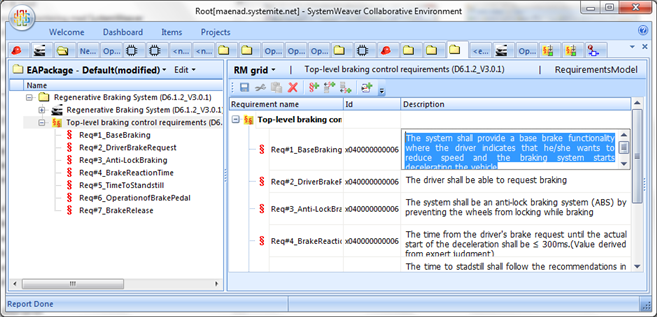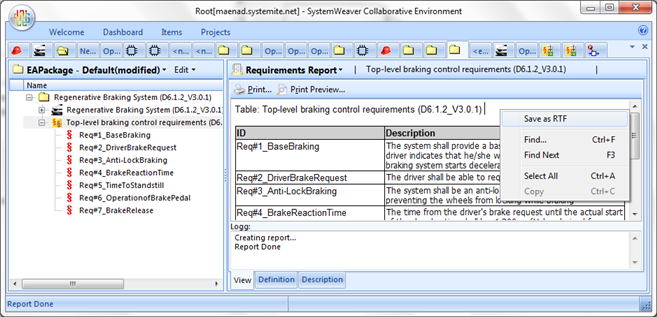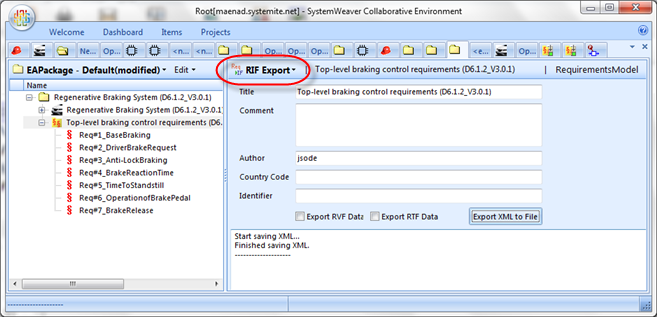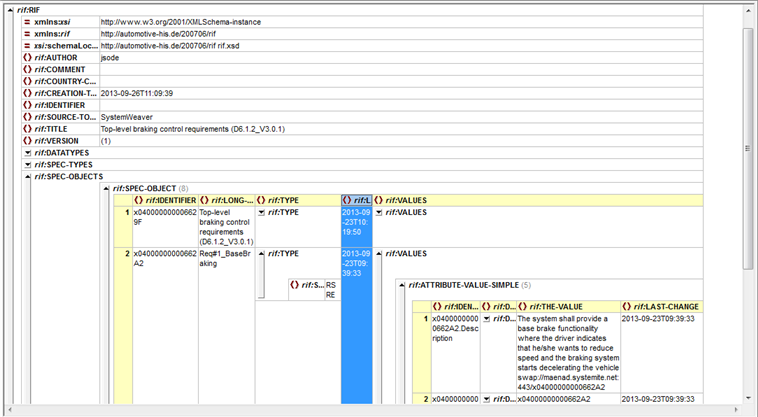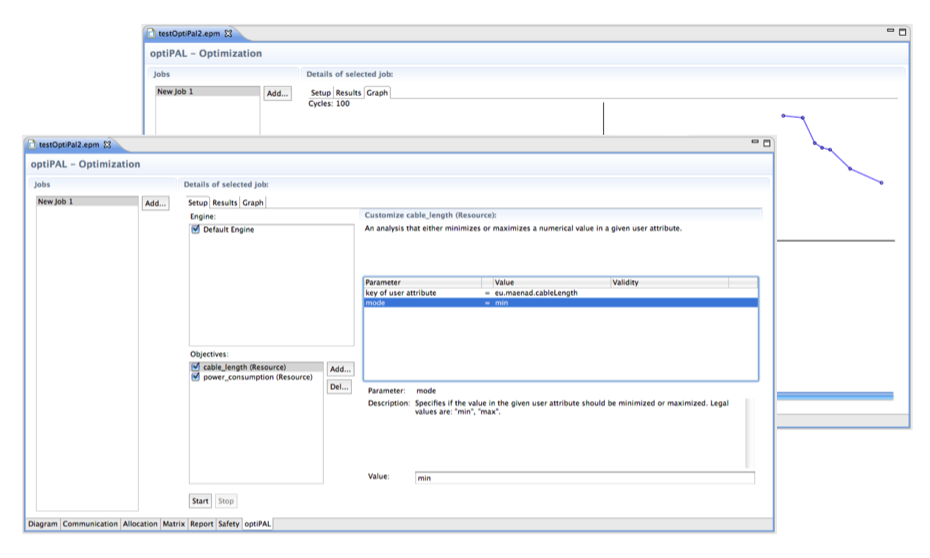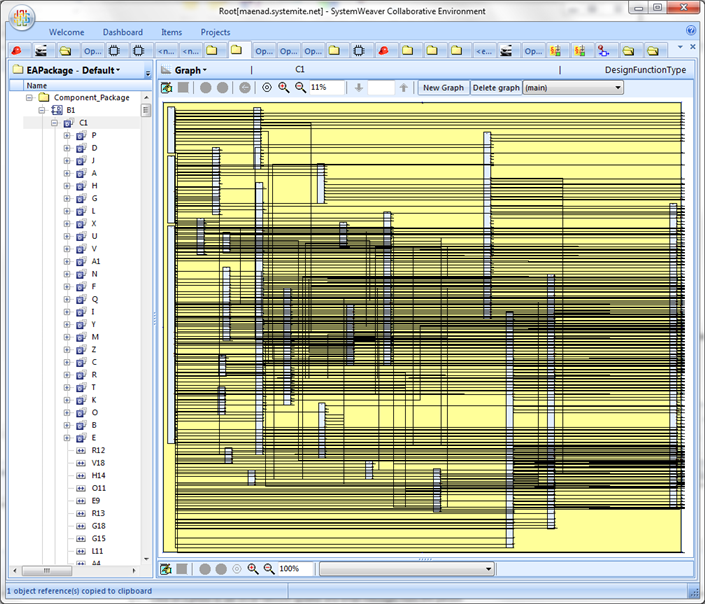Tooling Examples from Newsletter 8 | |
|
| |
|
Requirement Engineering in SystemWeaver and MetaEdit+For requirement engineering, EAST-ADL allows the requirements to be structured according to the system architecture and the development lifecycle. The language also provides modelling support for tracing each requirement to the related design solutions, verification and validation cases, detailed behaviour descriptions, as well as to its derived requirements. The SystemWeaver tool provides now support for the import of existing requirement descriptions in MS Office or similar tools by using the UI in applications like the swExplorer client. These imported requirements will be automatically structured in EAST-ADL based on EAXML format, shown in the figure below.
With the requirements descriptions structured in EAST-ADL, the users can then generate any kind of reports through the tool. A simple example seen below:
With the SystemWeaver tool, there is also support for exporting requirements in popular formats like RIF/ReqIF, shown below.
Similar tool features is also available in the MetaEdit+ tool, which allows the import of existing requirements description directly from MS EXCEL as well as the import of existing textual declarations of data types. This is illustrated with the figure below.
One important issue for quality management is about the traceability among requirements and design solutions. EAST-ADL captures the bindings of requirements and design artefacts with requirement satisfaction links. With the MetaEdit+ tool, such bindings can be shown either as graphic descriptions, or as binding matrixes, or as textual descriptions. The figure below shows one example requirement satisfaction matrix.
In EAST-ADL, behavior models can be associated to textual requirements statements for a formalized description. The figure below shows a state machine model for refining some textual ABS requirements.
Modelling and tool support for dependability engineeringEAST-ADL allows a wide range of functional safety related concerns (e.g. hazards, faults/failures, safety requirements) to be declared and structured according to ISO262622, while maintaining a seamless traceability to the lifecycle of nominal system development. Based on the EAST-ADL error model, a variety of safety analysis is being supported. This includes FMEA, FTA, and model-checking.
The figure below shows a dependability model for deriving the safety goals of an example propulsion control function.
For the safety analysis, error models capture the system internal faults, failures, error logic and propagations. Currently, a state-machine (SM) based definition of error behaviors is supported through the EAST-ADL temporal behavior constraint specification. This is shown below. The FTA analysis is supported through the HiPHOPS analysis engine. For more information, please refer to [DCDS2013].
Qompass time analysis applied on EAST-ADL modelsThe Qompass tool, add-on of Papyrus 0.10, has been enhanced for the provision of resource and timing analysis of east-adl models (See [LCTES 2013]). Typically, in early-stage phases only abstract views are available for the system so that allocation choices are limited to placement of functions to resources (no tasks and priorities are available for analysis of response times). At this stage resource constraints can be verified and different allocation candidates ranked according to resource-based metrics (bus and cpu utilization, function slack) can be compared.
Another approach applicable at early stage consists in using optimization to find the best solution among all possible partitioning of functions to tasks [LCTES13]. In this case the optimization outputs the ‘best allocation’ ever (e.g. allocation showing minimal latencies) and end-to-end constraints can be verified.
OptiPAL for multi-objective optimizationOne of the MAENAD project objectives was to investigate the integration of several analyses into a multi-objective optimization and to provide methods and experimental tools for conducting such optimizations base on a central EAST-ADL model. The below screenshots shows the prototype optimization tool developed during MAENAD. In the foreground, the configuration of a multi-objective optimization scenario can be seen, the background screenshots shows a visualization of a pareto-front.
EATOP InstanceRef dialogueThe enhanced tree browser on the EATOP platform has received a number of features that make it easier to navigate and view models. The main changes concern the editing of instance reference parameters.
Instance references can be edited in a simple mode and advanced mode. In the simple mode, the user only has to choose a target for the instance reference, and its context will be automatically deduced.
Selection of the instance reference target happens with the help of a dialogue box that shows model elements in a tree view. This tree view will reflect the virtual containment that arises from type-prototype relationships.
Once an instance reference has been completed, the path to the target will also be shown in a way that respects the type-prototype relationships.
The advanced mode allows the manual selection of context, as well as the option to disable the automatic completion of context from a target. This may be useful when working with incomplete or incorrect models.
Scalability: Design Functions from Large AUTOSAR file in SystemWeaverAs part of validating the ATL transformation technology for performance of large models, a real AUTOSAR 4.0 ECU Extract was transformed into an EAST-ADL Design Function Type. The specific ECU Extract included around 100 functions and around 4000 connected ports, and was transformed in less than a minute on a laptop computer, which proves this to be a viable solution also for industrial development. Below is a screenshot of the imported ECU Extract in the swExplorer of SystemWeaver:
References[DCDS2013] DeJiu Chen, Nidhal Mahmud, Martin Walker, Lei Feng, Henrik Lonn, Yiannis Papadopoulos. Systems Modeling with EAST-ADL for Fault Tree Analysis through HiP-HOPS. 4th IFAC Workshop on Dependable Control of Discrete Systems. York, U.K. September 4th- 6th, 2013 [LCTES 2013] Asma Mehiaoui, Ernest Wozniak, Sara Tucci-Piergiovanni, Chokri Mraidha, Marco Di Natale, Haibo Zeng, Jean-Philippe Babau Laurent Lemarchand. A Two-step Optimization Technique for Functions Placement, Partitioning, and Priority Assignment in Distributed Systems - Languages, Compilers and Tools for Embedded Systems, LCTES, Seattle, 2013.
| |
|
| |
|
Visit the project web site to find more information including the current language specification!
|
FP7 Strep #260057 Web Site: www.maenad.eu Contact: coordinator@maenad.eu

